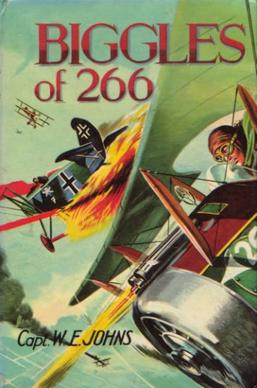
James Bigglesworth, nicknamed "Biggles", is a fictional pilot and adventurer, the title character and hero of the Biggles series of adventure books, written for young readers by W. E. Johns (1893–1968). Biggles made his first appearance in the story "The White Fokker", published in the first issue of Popular Flying magazine and again as part of the first collection of Biggles stories, The Camels Are Coming. Johns continued to write "Biggles books" until his death in 1968. The series eventually included nearly a hundred volumes – novels as well as short story collections – most of the latter with a common setting and time.

The Distinguished Flying Cross (DFC) is a military decoration of the United States Armed Forces. The medal was established on July 2, 1926, and is currently awarded to any persons who, after April 6, 1917, distinguish themselves by single acts of heroism or extraordinary achievement while participating in aerial flight. Both heroism and extraordinary achievement are entirely distinctive, involving operations that are not routine. The medal may be awarded to friendly foreign military members in ranks equivalent to the U.S. paygrade of O-6 and below in combat in support operations.

Air Florida Flight 90 was a scheduled U.S. domestic passenger flight operated by Air Florida from Washington National Airport to Fort Lauderdale–Hollywood International Airport, with an intermediate stopover at Tampa International Airport. On January 13, 1982, the Boeing 737-200 registered as N62AF crashed into the 14th Street Bridge over the Potomac River just after take off from Washington National Airport.
This is a list of aviation-related events from 1972.
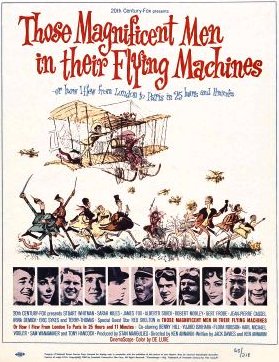
Those Magnificent Men in their Flying Machines or How I Flew from London to Paris in 25 Hours and 11 Minutes is a 1965 British epic period comedy film that satirises the early years of aviation. Directed and co-written by Ken Annakin, the film stars an international ensemble cast, including Stuart Whitman, Sarah Miles, Robert Morley, Terry-Thomas, James Fox, Red Skelton, Benny Hill, Jean-Pierre Cassel, Gert Fröbe and Alberto Sordi.
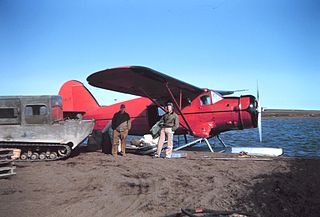
Bush flying refers to aircraft operations carried out in the bush. Bush flying involves operations in rough terrain where there are often no prepared landing strips or runways, frequently necessitating that bush planes be equipped with abnormally large tires, floats, skis or any other equipment necessary for unpaved runway operation. It is the only viable way of delivering people and supplies into more difficult to reach, remote locations.

Bernt Balchen was a Norwegian pioneer polar aviator, navigator, aircraft mechanical engineer and military leader. A Norwegian native, he later became an American citizen and was a recipient of the Distinguished Flying Cross.

Sir George Hubert Wilkins MC & Bar, commonly referred to as Captain Wilkins, was an Australian polar explorer, ornithologist, pilot, soldier, geographer and photographer. He was awarded the Military Cross after he assumed command of a group of American soldiers who had lost their officers during the Battle of the Hindenburg Line, and became the only official Australian photographer from any war to receive a combat medal. He narrowly failed in an attempt to be the first to cross under the North Pole in a submarine, but was able to prove that submarines were capable of operating beneath the polar ice cap, thereby paving the way for future successful missions. The US Navy later took his ashes to the North Pole aboard the submarine USS Skate on 17 March 1959.

The Italia was a semi-rigid airship belonging to the Italian Air Force. It was designed by Italian engineer and General Umberto Nobile who commanded the dirigible in his second series of flights around the North Pole. The Italia crashed in May 1928, with one confirmed fatality from the crash, one fatality from exposure while awaiting rescue, and six missing crew members who were trapped in the still-airborne envelope. At the end of the rescue operations there were a total of 17 dead and a number of survivors.

Air Commodore Charles Rumney Samson, was a British naval aviation pioneer. He was one of the first four officers selected for pilot training by the Royal Navy and was the first person to fly an aircraft from a moving ship. He also commanded the first British armoured vehicles used in combat. Transferring to the Royal Air Force on its creation in 1918, Samson held command of several groups in the immediate post-war period and the 1920s.

Cebu Pacific Flight 387 was a domestic flight from Ninoy Aquino International Airport in Metro Manila to Lumbia Airport in Cagayan de Oro. On February 2, 1998, the 30-year-old McDonnell Douglas DC-9-32 crashed on the slopes of Mount Sumagaya in Claveria. The incident resulted in the deaths of all 104 passengers and crew on board. It is the second deadliest air disaster in the Philippines after Air Philippines Flight 541, which occurred two years later.

Sabena Flight 571 was a scheduled passenger flight from Brussels to Tel Aviv via Vienna, operated by the Belgian national airline, Sabena. On 8 May 1972, a Boeing 707 passenger aircraft operating that service, captained by British pilot Reginald Levy, DFC, was hijacked by four members of the Black September Organization, a Palestinian terrorist group. Following their instructions, Captain Levy landed the plane at Lod Airport. The hijackers demanded that Israel release Palestinian prisoners in exchange for the hostages. The standoff was ended by an Israeli commando raid in which all of the hijackers were killed or captured.
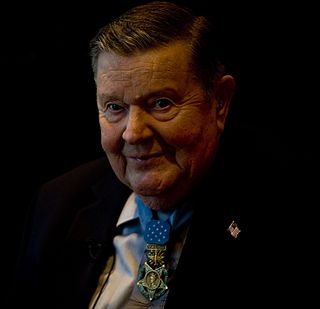
Joe Madison Jackson served as a career officer in the United States Air Force and received the Medal of Honor for heroism above and beyond the call of duty during the Vietnam War. On 12 May 1968, he volunteered for a dangerous impromptu rescue of three remaining Air Force members trapped at an overrun Army Special Forces camp. While the camp was still under heavy enemy fire from North Vietnamese and Viet Cong troops, he skillfully piloted his C-123 cargo plane and rescued the three men.
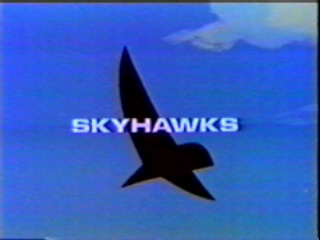
Skyhawks was a 17-episode television cartoon series sponsored by Mattel Toys. Each half-hour episode consisted of two adventures. The series originally aired from September 6, 1969 to September 4, 1971 on ABC. It was a Pantomime Picture Production and is distributed by CBS Television Distribution.

The Tuskegee Airmen is a 1995 HBO television movie based on the exploits of an actual groundbreaking unit, the first African-American combat pilots in the United States Army Air Corps, that fought in World War II. The film was directed by Robert Markowitz and stars Laurence Fishburne, Cuba Gooding Jr., John Lithgow, and Malcolm-Jamal Warner.

Lieutenant Colonel John Cyril Porte, was a British flying boat pioneer associated with the First World War Seaplane Experimental Station at Felixstowe.
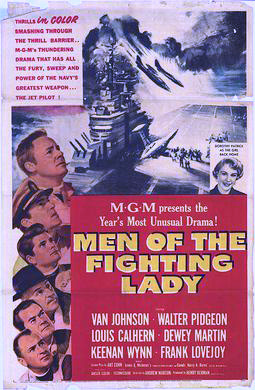
Men of the Fighting Lady is a 1954 American war drama film directed by Andrew Marton and starring Van Johnson, Walter Pidgeon, Louis Calhern and Keenan Wynn. The screenplay was written by U.S. Navy Commander Harry A. Burns, who had written a Saturday Evening Post article, "The Case of the Blinded Pilot", an account of a U.S. Navy pilot in the Korean War, who saves a blinded Navy pilot by talking him down to a successful landing. Men of the Fighting Lady was also inspired by another Saturday Evening Post article, "The Forgotten Heroes of Korea" by James A. Michener. The original music score was composed by Miklós Rózsa. It is also known as Panther Squadron. It is not to be confused with the 1944 documentary The Fighting Lady, which was mainly filmed aboard the USS Yorktown (CV-10).
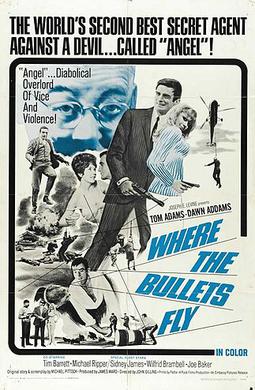
Where the Bullets Fly is a 1966 British comedy spy film directed by John Gilling and starring Tom Adams, John Arnatt, Dawn Addams, Tim Barrett and Michael Ripper.

The 1945 Japan–Washington flight was a record-breaking air voyage made by three specially modified Boeing B-29 Superfortresses on September 18–19, 1945, from the northern Japanese island of Hokkaidō to Chicago in the Midwestern United States, continuing to Washington, D.C. The flight was made by three United States Army Air Forces (USAAF) generals and other airmen returning to the United States from their overseas duty after World War II. At that date, it involved the then-heaviest load carried by an American aircraft, the longest nonstop flight made by the USAAF, and the first nonstop flight from Japan to the United States made by a complete aircraft. However the flight did not break the then-world distance record established by the Royal Air Force in 1938. It's worth noting that the Martin PB2M was rated at 144,000 lb much earlier. Also, the tests of the B-29 under the leadership of E.H. Rowley in June, 1945 with Grand Slam bombs may have been run at similar loads.

Crack-Up is a 1936 American film directed by Malcolm St. Clair. Peter Lorre plays a harmless, half-addled aircraft enthusiast who is actually a ruthless spy desperate to get his hands on the blueprints for an experimental aircraft for a trans-Atlantic flight. He faces off against Ace Martin, played by Brian Donlevy, the pilot of the aircraft, whose motives are spurred by feeling cheated by his own company. The supporting cast includes Helen Wood, Ralph Morgan and Thomas Beck.



















